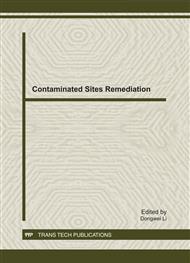[1]
Dewart J M, Bowen B M. Supplementary Documentation for an Environmental Impact Statement Regarding the Pantex Plant. LA-9445-PNTX-D. Los Alamos: Los Alamos National Laboratory, (1982).
DOI: 10.2172/823405
Google Scholar
[2]
Boughton B A, Delaurentis J M. Description and Validation of ERAD: An Atmospheric Dispersion Model for High Explosive Detonations. SAND92-2069-UC-702. Albuquerque: Sandia National Laboratory, (1992).
DOI: 10.2172/10183822
Google Scholar
[3]
Steele C M, Wald T L. Plutonium Explosive Dispersal Modeling Using the MACCS2 Computer Code. LA-UR-98-1901. Los Alamos: Los Alamos National Laboratory, (1998).
DOI: 10.2172/677008
Google Scholar
[4]
Hills C R, Chanin D I. Validation Study of Available Models For Consideration of Explosive Releases at Pantex Plant. RPT-30. Amarillo: Pantex Plant, (1998).
Google Scholar
[5]
Health Physics Society, What About Deadly Plutonium", Position statdopted March 1993. Information on www. hps. org.
Google Scholar
[6]
Anspaugh L R, Shinn J H, Phelps P L. Resuspension and Redistribution of Plutonium in Soils. UCRL-76419. San Francisco: Lawrence Livermore National Laboratory, (1975).
Google Scholar
[7]
Shinn J H. Estimation of Aerosol Plutonium Transport by the Dust-Flux Method: A Perspective on Application of Detailed Data. UCRL-78907. San Francisco: Lawrence Livermore National Laboratory, (1976).
Google Scholar
[8]
Shinn J H. Post-Accident Inhalation exposure and Experience with Plutonium. UCRL-JC-131173. San Francisco: Lawrence Livermore National Laboratory, (1998).
Google Scholar
[9]
Shinn J H. The Technical Basis for Air Pathway Assessment of Resuspended Radioactive Aerosols: LLNL Experiences at Seven Sites around the World. UCRL-JC-115045. San Francisco: Lawrence Livermore National Laboratory, (1993).
Google Scholar
[10]
Shinn J H, Homan D N, Hofmann C B. A Summary of Plutonium Aerosol Studies: Resuspension at the Nevada Test Site. UCRL-90746. San Francisco: Lawrence Livermore National Laboratory, (1986).
Google Scholar
[11]
Shinn J H, Patton S E, Gouveia F J. Seasonal Variations and Frequency Distributions of Plutonium Resuspension at Tonopah, Nevada. UCRL-JC-126286. San Francisco: Lawrence Livermore National Laboratory, (1997).
Google Scholar
[12]
Shinn J H. Assessing Inhalation Exposure from Airborne Soil Contaminants. UCRL-ID-130570. San Francisco: Lawrence Livermore National Laboratory, (1998).
DOI: 10.2172/641115
Google Scholar
[13]
Garcia O A, Iranzo C E. Resuspension and Transport of Plutonium in the Palomares Area, J. Environ. Radioactivity. 37(1997) 101-112.
DOI: 10.1016/s0265-931x(96)00076-8
Google Scholar
[14]
Iranzo C E, Salvador S. Potential Radiation Doses to People Living Near Plutonium Contaminated Areas in Palomares, Junta De Energia Nuclear - Spain. Presented at the 29th Annual Meeting of the Health Physics Society, New Orleans, June 3-8, (1984).
DOI: 10.1097/00004032-198704000-00006
Google Scholar
[15]
Iranzo C E, Salvador S. Air Concentrations of Pu-239 & Fu-240 and Potential Radiation Doses to Persons Living Near Pu-Contaminated Areas in Palomares, Spain. Health Physics. 52(1987) 453-461.
DOI: 10.1097/00004032-198704000-00006
Google Scholar
[16]
Iranzo C E, Espinosa A and Martinez J. Resuspension in the Palomares Area of Spain: A Summary of Experimental Studies, J. Aerosol Sci. 25(1994) 833-841.
DOI: 10.1016/0021-8502(94)90050-7
Google Scholar
[17]
Shinn J H. Complementary Pu Resuspension Study at Palomares, Spain. UCRL-ID-150980. San Francisco: Lawrence Livermore National Laboratory, (2002).
DOI: 10.2172/15002129
Google Scholar
[18]
Base standard for radioactive protection and safety,. Standards of the Peoples Republic of China, GB18871-2002,2003-4-1.
Google Scholar
[19]
Johnston P N, Lokan K H and Williams G A. Inhalation Doses For Aboriginal People Reoccupying Former Nuclear Weapons Testing Ranges in South Australia, Health Physics Vol. 63(1992) 631-640.
DOI: 10.1097/00004032-199212000-00003
Google Scholar
[20]
Haywood S M and Smith J G. Assessment of Potential Doses at the Maralinga and Emu Test Sites, Health Physics. 63 (1992) 624-630.
DOI: 10.1097/00004032-199212000-00002
Google Scholar


